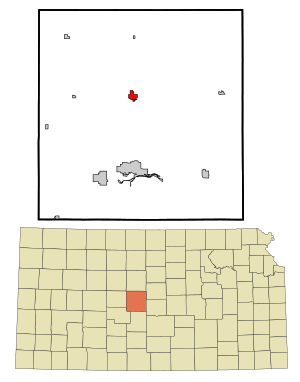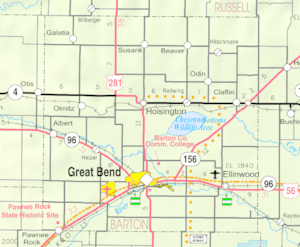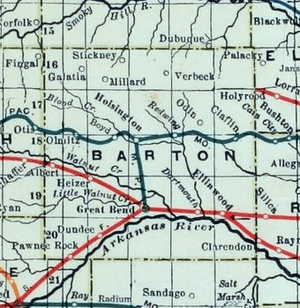Hoisington, Kansas facts for kids
Quick facts for kids
Hoisington, Kansas
|
|
|---|---|

Hoisington High School (2017)
|
|

Location within Barton County and Kansas
|
|

|
|
| Country | United States |
| State | Kansas |
| County | Barton |
| Founded | 1886 |
| Incorporated | 1887 |
| Named for | Andrew Hoisington |
| Area | |
| • Total | 1.16 sq mi (3.00 km2) |
| • Land | 1.16 sq mi (3.00 km2) |
| • Water | 0.00 sq mi (0.00 km2) |
| Elevation | 1,844 ft (562 m) |
| Population
(2020)
|
|
| • Total | 2,699 |
| • Density | 2,327/sq mi (899.7/km2) |
| Time zone | UTC-6 (CST) |
| • Summer (DST) | UTC-5 (CDT) |
| ZIP Code |
67544
|
| Area code | 620 |
| FIPS code | 20-32550 |
| GNIS ID | 475512 |
Hoisington is a city located in Barton County, Kansas, in the United States. In 2020, about 2,699 people lived there. It's a small but important community in central Kansas.
Contents
History of Hoisington

Hoisington was started in 1886 by a group of business people from Barton County. They formed a company called the Central Kansas Town Company. Their goal was to attract the Kansas and Colorado Railroad to the area.
The town was named after Andrew J. Hoisington. He was one of the company partners and a well-known businessman from nearby Great Bend. The railroad arrived in Hoisington in the fall of 1886. The settlement officially became a city in 1887. The local post office and railroad station were also renamed Hoisington around that time.
Growing with the Railroad
Hoisington grew steadily over the years. The city got its first power plant in 1903. A city water system was finished in 1904. The railroad, which was then known as the Missouri Pacific, was very important to the city's growth. By 1911, it employed 1,600 local men. Hoisington became a major hub for freight and passenger trains. It even had a roundhouse and repair shops.
Electric street lights were put up in 1915. The first streets were paved in 1917. The discovery of natural gas in 1929 and oil in the 1930s also helped the local economy grow.
The 2001 Tornado
On April 21, 2001, Hoisington faced a big disaster. An F4 tornado tore through the city. It traveled about 5 miles (8 km) and was about 3/8 of a mile (0.6 km) wide. The tornado came from the southwest and went right into the middle of the city.
Sadly, one person died, and many people were injured. Two hundred homes and 12 businesses were completely destroyed. Another 85 homes were badly damaged. About 200 more homes had minor damage. The city's population and businesses recovered quickly after the storm. Even today, you can still see where the tornado hit from the air. This is because there are fewer trees and some empty lots. Also, the newer houses built there are larger and more spread out.
Geography of Hoisington
Hoisington is located on the southern edge of the Smoky Hills region. This area is part of the larger Great Plains. Blood Creek flows east of the city and goes into Cheyenne Bottoms. Central Hoisington is about 5.5 miles (8.9 km) northwest of Cheyenne Bottoms by road.
The city is at the meeting point of U.S. Route 281 and K-4 in central Kansas. It is about 15 miles (24 km) north of Great Bend, which is the county seat. Hoisington is also about 105 miles (169 km) northwest of Wichita. It is about 234 miles (377 km) west-southwest of Kansas City.
The United States Census Bureau says that Hoisington covers a total area of 1.15 square miles (2.98 square kilometers). All of this area is land.
Population and People
| Historical population | |||
|---|---|---|---|
| Census | Pop. | %± | |
| 1890 | 446 | — | |
| 1900 | 789 | 76.9% | |
| 1910 | 1,975 | 150.3% | |
| 1920 | 2,395 | 21.3% | |
| 1930 | 3,001 | 25.3% | |
| 1940 | 3,719 | 23.9% | |
| 1950 | 4,012 | 7.9% | |
| 1960 | 4,248 | 5.9% | |
| 1970 | 3,710 | −12.7% | |
| 1980 | 3,678 | −0.9% | |
| 1990 | 3,182 | −13.5% | |
| 2000 | 2,975 | −6.5% | |
| 2010 | 2,706 | −9.0% | |
| 2020 | 2,699 | −0.3% | |
| U.S. Decennial Census | |||
2020 Census Information
The 2020 United States census counted 2,699 people living in Hoisington. There were 1,164 households, which are groups of people living together. The population density was about 2,327 people per square mile (898 per square kilometer).
Most of the people in Hoisington are white. About 7% of the population identified as Hispanic or Latino.
About 26% of the population was under 18 years old. The median age in the city was 39.2 years. This means half the people were younger than 39.2, and half were older.
Education in Hoisington
The public schools in Hoisington are part of the Hoisington USD 431 school district. There are four schools located in the city:
- Hoisington High School (for grades 9–12)
- Hoisington Middle School (for grades 5–8)
- Lincoln Elementary School (for grades 3–4)
- Roosevelt Elementary School (for Pre-Kindergarten–2)
Transportation in Hoisington
U.S. Route 281 runs north and south through Hoisington. It crosses and briefly shares the road with K-4, which runs east and west through the city.
The Hoisington Subdivision of the Kansas and Oklahoma Railroad runs east and west along the southern side of the city.
Media and Entertainment
Hoisington has two weekly newspapers: The Hoisington Dispatch and Tri-County News.
The Radio station KHOK is licensed to Hoisington. It broadcasts from Great Bend, Kansas on 100.7 FM. This station plays country music.
Fox TV channel KOCW is also licensed to Hoisington. It is a satellite station of KSAS-TV in Wichita.
Hoisington in Pop Culture
The April 2001 tornado was featured on an episode of The Weather Channel series Storm Stories. Also, the fact that the tornado hit during the high school prom was talked about on the NPR radio show This American Life. Many students at the prom didn't even know the tornado had struck!
The ABC comedy show Sports Night mentioned Hoisington in an episode from 1998. A character joked that the number of people at a sports game was the same as the population of Hoisington, Kansas. This was a funny way to fill time on the show.
Notable People from Hoisington
Many interesting people were born in or have lived in Hoisington, including:
- Walter Broadnax (1944–), a professor of public administration
- Doug Dumler (1950–), a football player
- Kathryn Eames (1908–2004), an actress
- Roy Ehrlich (1928–1997), a Kansas state politician
- Kari Wahlgren (1977–), a voice actress
See also
 In Spanish: Hoisington para niños
In Spanish: Hoisington para niños

